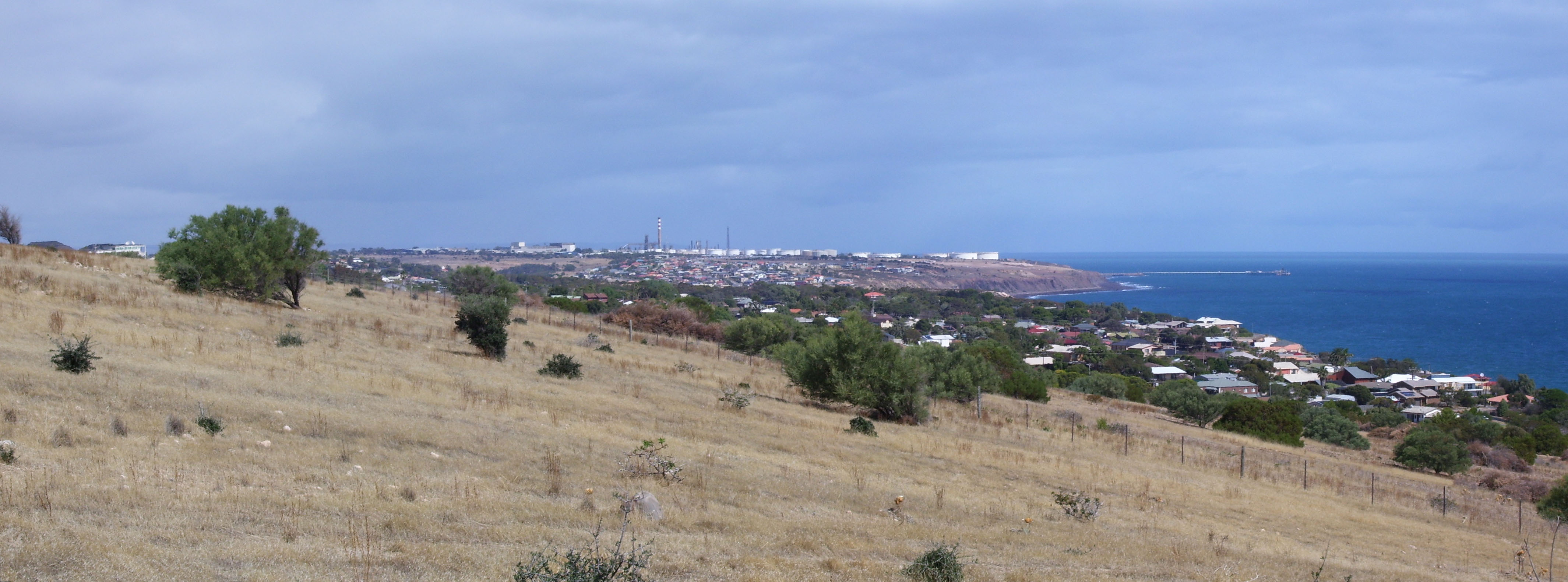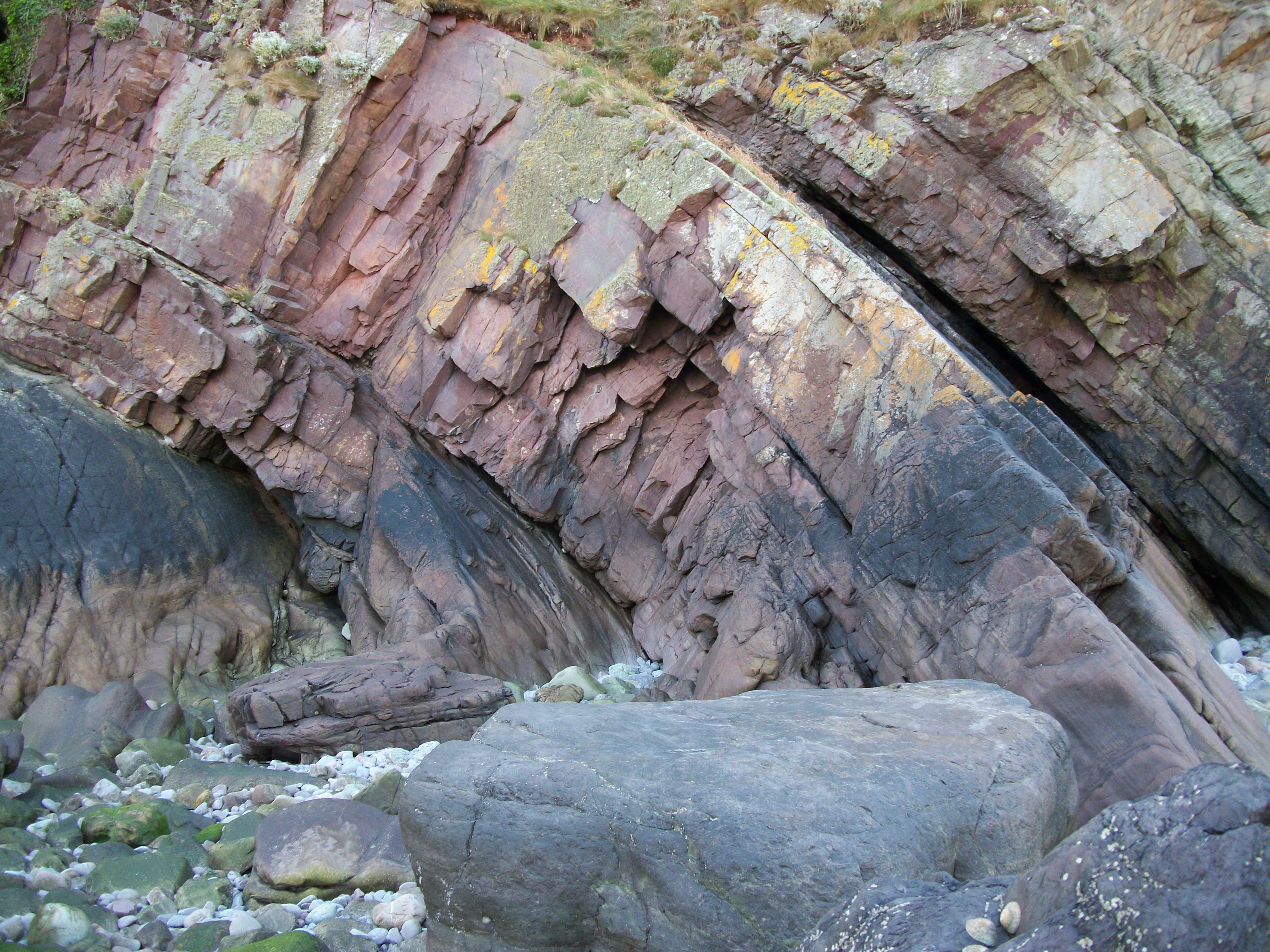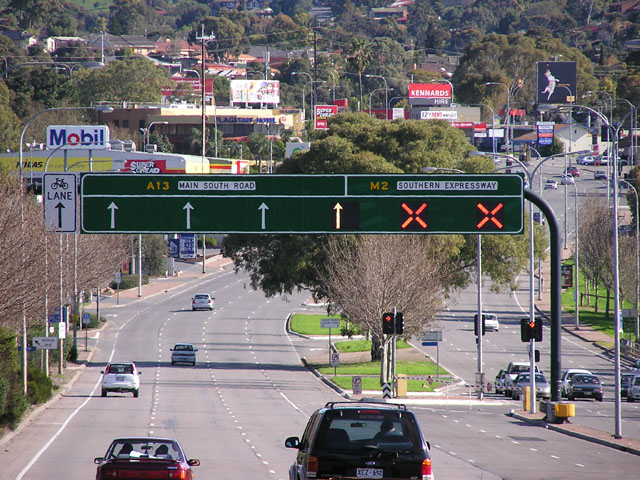|
Happy Valley Reservoir
The Happy Valley Reservoir is a water reservoir located in the southern Adelaide suburb of Happy Valley, South Australia. Constructed when the total population of Adelaide numbered 315,200 (1893 census), the Happy Valley Reservoir now supplies over half a million people, from Adelaide's southern extent to the city centre. The surrounding area is home to much wildlife, including many kangaroos. Construction Built between 1892 and 1897 at a cost of A$1.8 million it was the third reservoir constructed in South Australia as a supplement to the Thorndon Park Reservoir (built 1860) and the Hope Valley Reservoir (built 1872). The original Happy Valley township, school and cemetery were completely flooded by the new reservoir requiring their relocation. The township was moved to the east while the cemetery, which is still in use today, was moved to the west and relocated alongside the base of the dam wall. The school, originally located on Candy road, was relocated south to two acres ... [...More Info...] [...Related Items...] OR: [Wikipedia] [Google] [Baidu] |
Happy Valley, South Australia
Happy Valley is a metropolitan suburb of Adelaide, South Australia. It is located 20 km south of the Central Business District of Adelaide. Within the suburb is the Happy Valley Reservoir accompanied by South Australia's largest water treatment plant, responsible for supplying water to much of the Adelaide metropolitan area. Although it is now encompassed by suburbs, it still retains a relatively semi-rural character due to retention of native flora and vegetation surrounding the Happy Valley Reservoir, as well as parklands and golf courses along its border. History In November 1844, Daniel George Brock recorded in his diary details of a journey south from Adelaide. On his third day he rode past Thomas O’Halloran's farm, on the hill noting that the land had little running water and was suitable for wheat farming. Some few kilometres to the east he came to Happy Valley. There, he noted, were 'several substantial stone buildings, among which is a neat little chapel'. ... [...More Info...] [...Related Items...] OR: [Wikipedia] [Google] [Baidu] |
Nine Network
The Nine Network (stylised 9Network, commonly known as Channel Nine or simply Nine) is an Australian commercial free-to-air television network. It is owned by parent company Nine Entertainment and is one of five main free-to-air television networks in Australia. From 2017 to 2021, the network's slogan has been "We Are the One". Since 2021, the network has changed its slogan back to the iconic Golden Era slogan "Still the One". As of 2022, the Nine Network is the second-rated television network in Australia, behind the Seven Network, and ahead of the ABC TV, Network 10 and SBS. History Origins The Nine Network's first broadcasting station was launched in Sydney, New South Wales, as TCN-9 on 16 September 1956 by ''The Daily Telegraph'' owner Frank Packer. John Godson introduced the station and former advertising executive Bruce Gyngell presented the first programme, ''This Is Television'' (so becoming the first person to appear on Australian television). Later that year, GT ... [...More Info...] [...Related Items...] OR: [Wikipedia] [Google] [Baidu] |
Hallett Cove Conservation Park
Hallett Cove Conservation Park is a protected area in the Australian state of South Australia located in the suburb of Hallett Cove on the coast of Gulf St Vincent about south of the centre of the state capital of Adelaide. Hallett Cove is one of the best known geological sites in Australia and is known for its international significance. The area has been declared a Geological Monument by the Geological Society of Australia and placed on the South Australian Heritage Register for its educational and scientific significance. It is also a site of great archaeological significance, with evidence of some of the earliest Aboriginal settlement documented in Australia, dated at 40,000 years ago. Some of the features in the park are Waterfall Creek, Black Cliff and the Amphitheatre. A freshwater spring near Waterfall Creek is one of the features of the Tjilbruke Dreaming Track. the park is included in the Glenthorne Precinct of protected areas. History Aboriginal occupation Abor ... [...More Info...] [...Related Items...] OR: [Wikipedia] [Google] [Baidu] |
Field River
The Field River is an urban watercourse located in the southern suburbs of Adelaide in the Australian state of South Australia. Course and features Part of the Onkaparinga River catchment that drains the western slopes of the Mount Lofty Ranges, the Field River has a total area of and drains the Happy Valley Reservoir, part of Main South Road and the Southern Expressway. Suburbs bordering the river include Hallett Cove, Reynella, Shiedow Park, Trott Park, Happy Valley and Woodcroft. The stream flow of the Field River is highly seasonal and variable with an average annual runoff of . The majority of the stream can dry out completely during summer, staying that way well into autumn. The final portion of the river is spring fed and flows into the Gulf St Vincent all year round. The Field River flows through or is bordered by the City of Marion and City of Onkaparinga. The lower reaches of the river ran through private property owned by the Sheidow family until 1993 when ... [...More Info...] [...Related Items...] OR: [Wikipedia] [Google] [Baidu] |
Marino Conservation Park
__NOTOC__ Marino Conservation Park is a protected area in the Australian state of South Australia located in the Adelaide suburb of Marino, overlooking both parts of the Adelaide metropolitan area and the coastline with Gulf St Vincent. Situated on the lands of the Aboriginal Kaurna people, the Marino Conservation Park and surrounding areas are part of the Tjilbruke dreamtime. Proclaimed in 1989 as a conservation park, it aims to protect flora such as the ground cover desert saw sedge ('' Gahnia lanigera'') and twiggy daisy bush ('' Olearia ramulosa'') and native grass species of genera such as ''Danthonia'' and ''Stipa'', and groundcovers that dominate the central and eastern portions of the conservation park. The elegant wattle (''Acacia victoriae'') can also be seen in the conservation park. The steep west-facing hillside above the railway line contains a very significant remnant area of coastal heath vegetation, including rare plants such as lemon beauty heads Calocep ... [...More Info...] [...Related Items...] OR: [Wikipedia] [Google] [Baidu] |
Glenthorne Precinct
Glenthorne () is a 13.3 hectare geological Site of Special Scientific Interest in the parish of Oare within the Exmoor National Park, on the border of Somerset and Devon, notified in 1989. Glenthorne is a Geological Conservation Review site because of the Trentishoe Formation of the Hangman Sandstone Group. The Hangman Sandstone represents the Middle Devonian The Devonian ( ) is a geologic period and system of the Paleozoic era, spanning 60.3 million years from the end of the Silurian, million years ago (Mya), to the beginning of the Carboniferous, Mya. It is named after Devon, England, w ... sequence of North Devon and Somerset. These are unusual freshwater deposits in the Hangman Grits, which were mainly formed in desert conditions. References External links English Nature website(SSSI information) {{SSSIs Somerset geological Sites of Special Scientific Interest in Devon Sites of Special Scientific Interest in Somerset Sites of Special Scientific Inte ... [...More Info...] [...Related Items...] OR: [Wikipedia] [Google] [Baidu] |
Green Energy
Energy is sustainable if it "meets the needs of the present without compromising the ability of future generations to meet their own needs". Most definitions of sustainable energy include considerations of environmental aspects such as greenhouse gas emissions and social and economic aspects such as energy poverty. Renewable energy sources such as wind, hydroelectric power, solar, and geothermal energy are generally far more sustainable than fossil fuel sources. However, some renewable energy projects, such as the clearing of forests to produce biofuels, can cause severe environmental damage. The role of non-renewable energy sources in sustainable energy has been controversial. Nuclear power is a low-carbon source whose historic mortality rates are comparable to wind and solar, but its sustainability has been debated because of concerns about radioactive waste, nuclear proliferation, and accidents. Switching from coal to natural gas has environmental benefits, including a l ... [...More Info...] [...Related Items...] OR: [Wikipedia] [Google] [Baidu] |
Solar Panel
A solar cell panel, solar electric panel, photo-voltaic (PV) module, PV panel or solar panel is an assembly of photovoltaic solar cells mounted in a (usually rectangular) frame, and a neatly organised collection of PV panels is called a photovoltaic system or solar array. Solar panels capture sunlight as a source of radiant energy, which is converted into electric energy in the form of direct current (DC) electricity. Arrays of a photovoltaic system can be used to generate solar electricity that supplies electrical equipment directly, or grid-connected photovoltaic system, feeds power back into an alternate current (AC) electric grid, grid via an solar inverter, inverter system. History In 1839, the ability of some materials to create an electrical charge from light exposure was first observed by the French physicist Edmond Becquerel. Though these initial solar panels were too inefficient for even simple electric devices, they were used as an instrument to measure light. ... [...More Info...] [...Related Items...] OR: [Wikipedia] [Google] [Baidu] |
The Advertiser (Adelaide)
''The Advertiser'' is a daily tabloid format newspaper based in the city of Adelaide, South Australia. First published as a broadsheet named ''The South Australian Advertiser'' on 12 July 1858,''The South Australian Advertiser'', published 1858–1889 National Library of Australia, digital newspaper library. it is currently a tabloid printed from Monday to Saturday. ''The Advertiser'' came under the ownership of in the 1950s, and the full ownership of in 1987. It is a publication of Advertiser Newspapers Pty Ltd (ADV), ... [...More Info...] [...Related Items...] OR: [Wikipedia] [Google] [Baidu] |
South Road
South Road and its southern section as Main South Road outside of Adelaide is a major north–south conduit connecting Adelaide and the Fleurieu Peninsula, in South Australia. It is one of Adelaide's most important arterial and bypass roads. As South Road, it is designated part of route A2 within suburban Adelaide, and as Main South Road, it is designated part of routes A13 and B23. The northern part of South Road contributes the central component of the North–South Corridor, a series of road projects under construction or planning that will eventually provide a continuous expressway between Old Noarlunga and Gawler. Route South Road commences from the intersection with Port River Expressway and Salisbury Highway in Wingfield and runs directly south, through much of Adelaide's inner western suburbs, close to the Adelaide city centre; it is complimented by (and in some instances, subsumed into) the North-South Motorway and either runs directly underneath it at ground level wi ... [...More Info...] [...Related Items...] OR: [Wikipedia] [Google] [Baidu] |
Plantation
A plantation is an agricultural estate, generally centered on a plantation house, meant for farming that specializes in cash crops, usually mainly planted with a single crop, with perhaps ancillary areas for vegetables for eating and so on. The crops that are grown include cotton, coffee, tea, cocoa, sugar cane, opium, sisal, oil seeds, oil palms, fruits, rubber trees and forest trees. Protectionist policies and natural comparative advantage have sometimes contributed to determining where plantations are located. In modern use the term is usually taken to refer only to large-scale estates, but in earlier periods, before about 1800, it was the usual term for a farm of any size in the southern parts of British North America, with, as Noah Webster noted, "farm" becoming the usual term from about Maryland northwards. It was used in most British colonies, but very rarely in the United Kingdom itself in this sense. There, as also in America, it was used mainly for tree plantati ... [...More Info...] [...Related Items...] OR: [Wikipedia] [Google] [Baidu] |
Koala
The koala or, inaccurately, koala bear (''Phascolarctos cinereus''), is an arboreal herbivorous marsupial native to Australia. It is the only extant representative of the family Phascolarctidae and its closest living relatives are the wombats. The koala is found in coastal areas of the mainland's eastern and southern regions, inhabiting Queensland, New South Wales, Victoria, and South Australia. It is easily recognisable by its stout, tailless body and large head with round, fluffy ears and large, spoon-shaped nose. The koala has a body length of and weighs . Fur colour ranges from silver grey to chocolate brown. Koalas from the northern populations are typically smaller and lighter in colour than their counterparts further south. These populations possibly are separate subspecies, but this is disputed. Koalas typically inhabit open '' Eucalyptus'' woodland, as the leaves of these trees make up most of their diet. Because this eucalypt diet has limited nutritional and ... [...More Info...] [...Related Items...] OR: [Wikipedia] [Google] [Baidu] |







